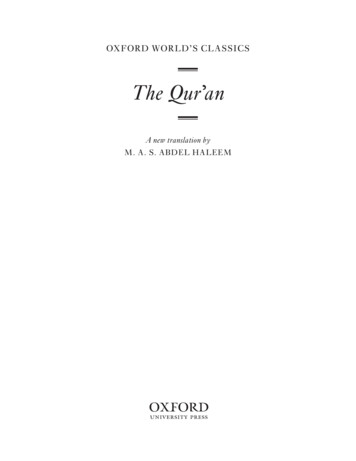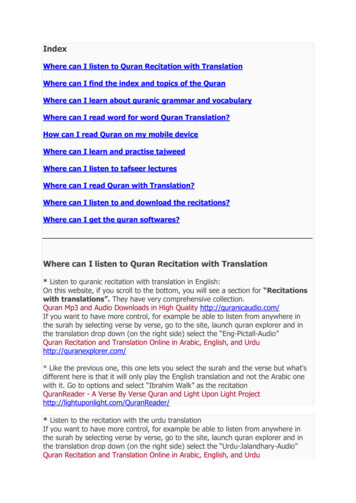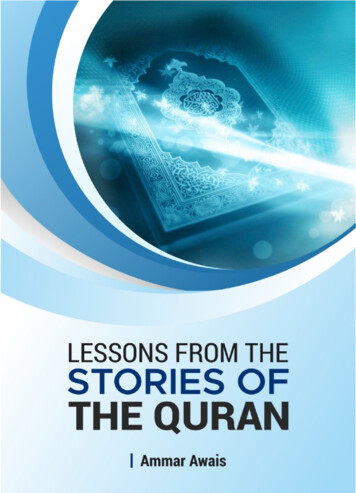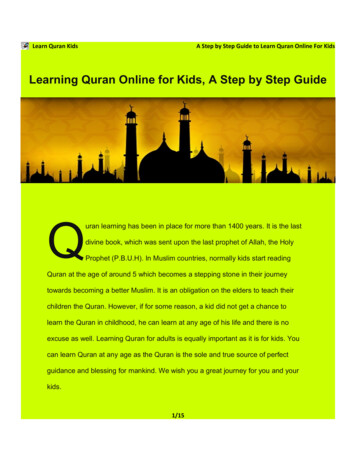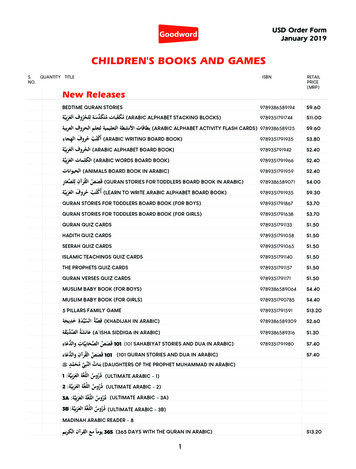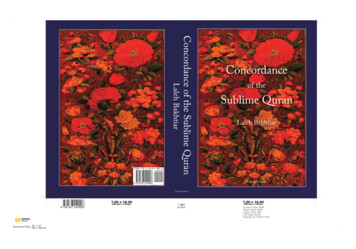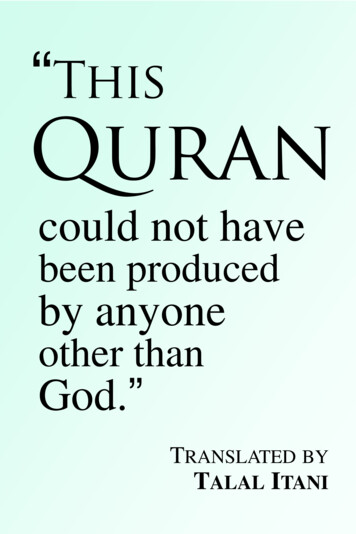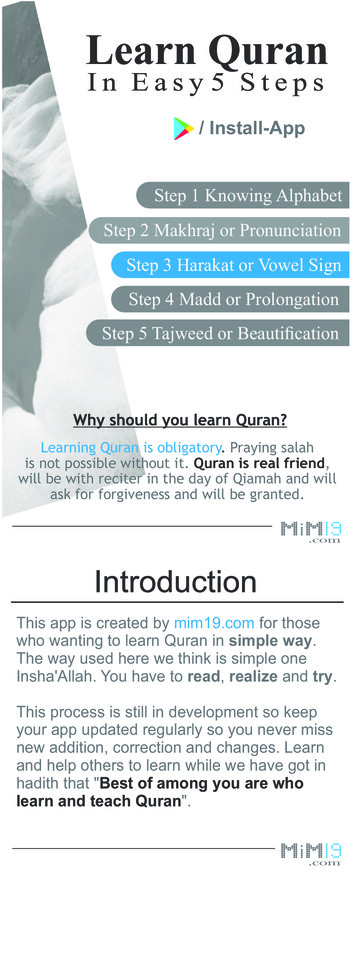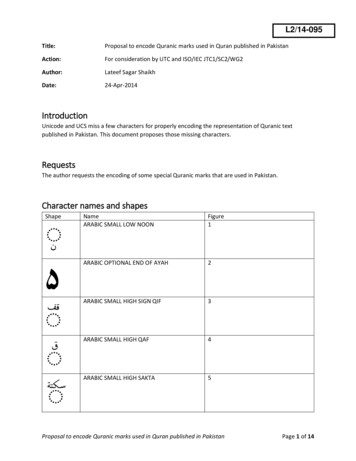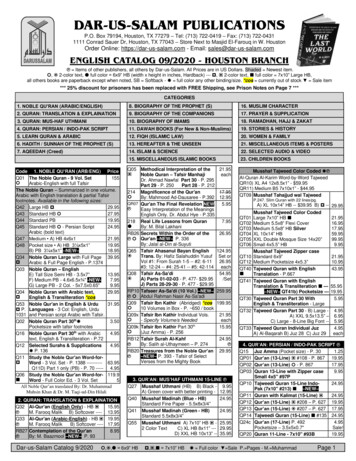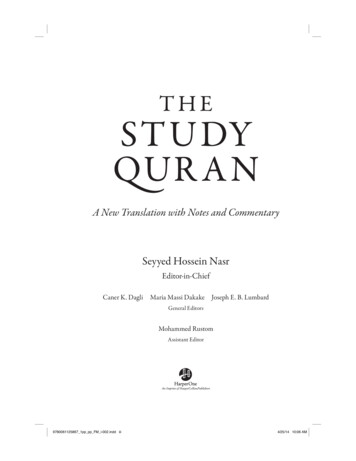
Transcription
THEST UDYQUR A NA New Translation with Notes and CommentarySeyyed Hossein NasrEditor-in-ChiefCaner K. Dagli Maria Massi DakakeJoseph E. B. LumbardGeneral EditorsMohammed RustomAssistant Editor!"# %&&'(#%")&**)**) ,)-. '/-011222---34'(4&3222& 5 %26,
!"# %&'()* ,-%./'0#& %1% *122%./ 0# 3%4/'*%-" %5122 6 %'4%-" %4'/-"('*#,5%!"# %&'#()*%781. /9, :%; ?@%!" %1,,'-1- &%('** ,-1/6%./'0#& &%" / %31 %./ .1/ &%A6%B' ."%C)*A1/&@%9-" /% (-#', %'4%-" %1,,'-1- &%('** ,-1/6%3 / %./ .1/ &%A6%D1/#1%E1F1F :%G1, /%E152#:%1,&%D'"1** &%H) -'*@%I'/%A#A2#'5/1."# %1,&%(#-#,5%-" %3'/F%1 %1%3"'2 J%%K1 /:%L 66 &%8' #,:%G1, /%M@%E152#:%D1/#1%D1 #%E1F1F :%B' ."%N@%O@%C)*A1/&:%1,&%D'"1** &%H) -'*:% & @:% ,-&!"# %&'#()*%7L1,%I/1,(# ('J%81/. /9, :%; ?@%%I'/%,'- J%%P" ,%(#-#,5%-" %"()*./)"01*2%1--/#A)-#',% "')2&%A %-'%K1 /:%E152#:%E1F1F :%1,&%C)*A1/&%-'5 -" /:% @5@%% ,-&!"# %&'#()*:%-/1, @%L@%8@%K1 /:%G@%M@%E152#:%D@%D1 #%E1F1F :%1,&%B@%N@%O@%C)*A1/&%7L1,%I/1,(# ('J%81/. /9, :%; ?:% Q@%%%P" ,%(#-#,5%-" %1,,'-1- &%('** ,-1/62%1--/#A)-#',% "')2&%A %-'%-" %./#*1/6%1)-"'/%4'/%-"1-%('** ,-1/6:%1 %& -1#2 &%1A'0 :% @5@%%%B' ."%N@%O@%C)*A1/&:%('** ,-1/6%',% RJ %#,% ,-&!"# %&'#()*:% &@%L@%8@%K1 /% -%12@:%7L1,%I/1,(# ('J%81/. /9, :%; ?:% Q@%%%
Understanding the Citationsin the CommentaryPassages from the QuranWhen a passage from this translation of the Quran is quoted in the commentary, it appearsin italics. For example, in the following sentence from the commentary on 3:18, the italicizedwords come from the translation of 3:18:Upholding justice is thought by most to refer to God or He, but grammatically itcould refer to the angels and possessors of knowledge as well.Longer Quranic quotations in the commentary are italicized as well. Alternate translationsor variant readings appear in standard quotation marks. Thus, all italicized words in Englishin the commentary are words or passages from this translation. Transliterated Arabic words,such as adīth and tafsīr, also appear in italics.Unless otherwise identified, all references in the form of two numbers separated by a colondenote Quranic passages. For example, 12:34 refers the 34th verse (or āyah) of the 12th chapter(or sūrah) of the Quran. The numbering of the verses matches that of the standard Egyptianedition, which is found in other widely distributed editions such as the Mu af al-Madīnah.Other translations, such as those of Yusuf Ali and Muhammad Marmaduke Pickthall, number verses somewhat differently in a few cases. This difference exists because traditionallyscholars, while agreeing on the text, have disagreed about where some verses end and othersbegin. The most famous example of this is in the Fāti ah, the first sūrah of the Quran. According to some scholars, its first verse is In the Name of God, the Compassionate, the Merciful,while others say it begins with Praise be to God, the Lord of the worlds.!"# %&&'(#%")&**)**) ,)-. '/-01122234-56'(6&5222& 7 %28,
Understanding the Citations in the CommentaryxliiReferences to the Sayings of the ProphetRather than appearing in the commentary text, full citations for the sayings of the Prophet(sing. adīth, pl. a ādīth) are located in Appendix A, in the sequence they appear in the commentary. Sayings of the Prophet are cited in the text using standard quotation marks.References to the Traditional Commentators on the QuranThroughout the commentary, capital letters in parentheses follow immediately after variousopinions or interpretations. These letters correspond to the commentators listed in the “Commentator Key,” whose biographies are provided in Appendix C. For example, when one readsin the commentary on 12:34 the phrase, “Some interpret x to mean y ( ),” this means that theopinion is to be found mentioned in al- abarī’s commentary on 12:34. This does not meanthat it is al- abarī’s personal opinion, only that the argument or interpretation can be founddiscussed or recorded by al- abarī, whether he accepts or rejects it. By extension “(R, Q, )”means that some interpretations can be found in multiple sources. These citations are notmeant to be exhaustive; very often a given opinion will be found in dozens of commentaries, though only one is cited. We have generally preferred to mention those that are the mostwidely available and universally recognized.Other times the individual opinions of these commentators are cited, as are those of otherIslamic scholars such as al-Ghazzālī (d. 505/1111). For example, “According to al-Rāzī ” signifies the personal opinion of al-Rāzī, not only an opinion that he records in his commentaryfrom his contemporaries or earlier sources. Opinions other than al-Rāzī’s own but discussedby him would be cited using “(R).”Full scholarly citations of all the interpretations and opinions in this commentary wouldhave been impractical for a work of this kind. However, writing a commentary without any citations, although it would have saved space and smoothed the style, would have severed a crucialand fruitful connection to the tradition and left our commentary unmoored and ambiguous inits sourcing. Since the traditional commentaries are also histories of the intellectual activity ofinterpreting the Quran, and since they are arranged verse by verse in sequence like the presentwork, citing them in the commentary maintains transparency without weighing down the textwith innumerable book titles and page numbers. All of the commentaries we cite exist in printand are also available from various dependable online resources, such as altafsir.org.These citations serve several functions. First, they make clear which elements in the commentary come directly from the traditional commentaries and which parts constitute analysis andcontributions by the editors. Second, they provide a research tool for further scholarly investigation. Third, since the traditional commentaries are slowly becoming available in English, thesecitations will allow English readers easier access to the traditional scholarship on the Quran.Cross-ReferencesCross-references in the commentary text use a lowercase c appended to a verse number to indicate a cross-reference to another portion of the commentary. For example, “See also 24:35c”means “See also the commentary on 24:35.”!"# %&&'(#%")&**)**) ,)-. '/-01122234--56'(6&5222& 7 %28,
Commentator KeyAFAbu’l-FutūAjA mad ibn Ajībah (d. 1224/1809), "%& " * "%&,"- - . /".0 * "%&12* ) "%&,"' -ĀlShihāb al-Dīn al-Ālūsī (d. 1270/1854), !#"3 %&0"4 "%&,"/5 )ĀsMu ammad al- āhir ibn Āshūr (d. 1393/1973), "%&6" * * #"3 %&/")# *BAbd Allāh ibn Umar ibn Mu ammad al-Bay āwī (d. 685/1286), 7)# * "%&/")8 % #" "0* * "%&/" # %BgAl- usayn ibn al-Farrā al-Baghawī (d. 516/1122), 9" %(, "%&/")8 %BqBurhān al-Dīn Abu’l- asan Ibrāhīm al-Biqā ī (d. 885/1480), :" , "%&-2*"* . /") 024 "%& ; / #"3 %&02#"*IAQā ī Abū Bakr Mu ammad ibn Abd Allāh ibn al- Arabī (d. 543/1148), 7 , "%&12* )IIsmā īlIJAbu’l-Faraj Abd al-Ra mān ibn Alī ibn al-Jawzī (d. 597/1201), - "%&,"0 * . (%, "%&/".0 *IKImād al-Dīn Abu’l-Fidā Ismā īl ibn Umar ibn Kathīr (d. 774/1373), 6".0 * "%&12* ) "%& " ,!"# %&&'(#%")&**)**) ,)-. '/-01122234---usayn ibn Alī al-Rāzī (d. 525/1131), !"# "%&'() ) #" * "%&'") ) "%&," ) . /".0 * "%&12* ) "%& " , aqqī al-Burūsawī (d. 1137/1725), ! "%&4"; )56'(6&5222& 7 %28,
Commentator KeyxlivIAl-Rāghib al-I fahānī (d. 502/1108), !"# %& '(%)# (%)* " ,IAbū Mu ammad Abd al- aqq ibn A iyyah al-Andalusī (d. 541/1147), %)*!" % % (%)*-%. /(# ('%#0 (%)*12' 3(%)* %/ /JJJalāl al-Dīn al-Ma allī (d. 864/1459) and Jalāl al-Dīn al-Suyū ī (d. 911/1505),4%#0 (%)*5%) )%6,KAbd al-Razzāq al-Kāshānī (d. 736/1336), 4% - )(%)* " ,(%)*1% 7, known bymany as 4%#0 (23,( 8 %3KāMu ammad Mu sin al-Fay al-Kāshānī (d. 1091/1680), 4%#0 (%)* #KlMu ammad ibn A mad ibn Juzayy al-Kalbī (d. 741/1340), %)*4%09 )()2* ") 7(%)*'%,/ )MAbū Man ūr Mu ammad ibn Mu ammad al-Māturīdī (d. 333/944), 4% - ) '(%9)(%)*0",,%9Madr al-Dīn al-Shīrāzī (Mullā adrā; d. 1050/1640), 4%#0 (%)* " ,(%)*1% 7MuMuqātil ibn Sulaymān (d. 150/767),(4%#0 (!": '2)(23,(;")%67 ,MwAlī ibn Mu ammad al-Māwardī (d. 450/1058),(%)* "1%'(-% )* "6 ,(# ('%#0 (%)* " ,MyRashīd al-Dīn al-Maybudī (d. ca. 520/1126), %09#(%)*%0 (-%( "&&%'(%)*%3 NAbd Allāh ibn A mad al-Nasafī (d. 710/1310), !%& 21(%)*'%,/ )(-%( %: 2:%)*'% - )NiNi ām al-Dīn asan al-Nīsābūrī (or al-Naysābūrī; d. 728/1328),(4%#0 (?9% 23(%)* " ,(-%( %?9 23(%)*#" : ,QAbū Abd Allāh Mu ammad ibn A mad al-Qur ubī (d. 671/1272), %)*5 72 ()2*% 1 7(%)* " ,QbSayyid Qu b (d. 1386/1966), @ ( 2) )(%)* " ,QmAlī ibn Ibrāhīm al-Qummī (d. 328/939), 4%#0 (%)* " ,QuAbu’l-Qāsim al-Qushayrī (d. 465/1072), A%RFakhr al-Dīn al-Rāzī (d. 606/1210), %)*4%#0 (%)*1%3 RbRūzbihān Baqlī al-Shīrāzī (d. 606/1209), 8 20(%)*3%6 ,(# ( %: 2:(%)* " ,SaNa r ibn Mu ammad al-Samarqandī (d. 373/983), B% (%)* ") 7ShMu ammad ibn Alī al-Shawkānī (d. 1250–55/1834–39), @%' (%)*:%& STSahl ibn Abd Allāh al-Tustarī (d. 283/896), 4%#0 (%)* " ,(%)* % 7(!"# %&&'(#%")&**)**) ,)-. '/-01122234-52#(%)*209 '67'(7&6222& 8 %29,
xlvCommentator KeySuAbd al-Ra mān al-Sulamī (d. 412/1021), !" #" !%&'!() *SyJalāl al-Dīn al-Suyū ī (d. 911/1505), !%& ,** !%&-!.'/ * ( '!() * !%&-! '/ *Mu ammad ibn Jarīr al- abarī (d. 310/923), 0 -# !%&1!2 . !. '! 3 % 2 !%&4,* .!b!Mu ammad usayn al- abā abā ī (d. 1401/1981), !%&5 6 . ( '!() * !%&4,* .ThAbd al-Ra mān ibn Mu ammad al-Tha ālibī (d. 873/1468), !%&0!3 /#* !%& #) . ( '!() * !%&4,* .THA mad ibn Mu ammad al-Tha labī (d. 427/1035), !%&7!)/( 3!8 %&1!2 . !. '!() * !%&4,* .!sAbū Alī al-Fa l ibn al- asan al- abrisī (or al- abarsī; d. 548/1153–54), 5!9-! !%&1!2 . ( '!() * !%&4,* .!ūMu ammad ibnasan al- ūsī (d. 460/1067), !%&:#12 . ( '!() * !%&4,* .WAbu’l- asan Alī ibn A mad al-Wā idī (d. 468/1076), ;)1 1 .,6 % !%&4,* .ZAbu’l-Qāsim Ma mūd ibn Umar al-Zamakhsharī (d. 538/1144), !%&7!)/)/ ( !. /!3 -# !" #" !%&'!.6 % 3! ,2 . !%&!" 3 % ( 3,9 / !%&'! 3 %!"# %&&'(#%")&**)**) ,)-. '/-01122234567'(7&6222& 8 %29,
36Yā SīnY SnThere is consensus among all scholars that Yā Sīn is a Makkan sūrahfrom the early part of the middle Makkan period. Some maintain thatthe whole of the sūrah is Makkan, though many commentators believe that v. 12 is from the Madinan period. The sūrah takes its name from themention of the Arabic letters yā and sīn in the opening verse. Some also referto it as “The Heart of the Quran,” after a well-known adīth: “Everything hasa heart, and the heart of the Quran is Yā Sīn. Whosoever recites Yā Sīn, Godrecords for him the recitation of the Quran ten times for his recitation of it”(Āl, Q).Seen as the heart of the Quran, this sūrah plays a very important role intraditional Islamic piety. Many Muslims recite Yā Sīn regularly as part of theirsupererogatory devotions, and it is often the only sūrah longer than a page or sothat Muslims have memorized in full. A famous adīth says, “Recite Yā Sīn overyour dead” (Q, Sy). It is thus recited for those who are close to death, those whohave just died, and at the graves of loved ones. It is also recited for those whoare sick, for another adīth states, “Verily, in the Quran there is a sūrah thatheals through its recitation and forgives through its being heard—indeed, thatis Sūrat Yā Sīn” (Āl, Q). Yā Sīn is also recited by many Muslims after the performance of the obligatory prayers in the morning and the evening. Regardingthe latter, another report, sometimes recorded as a adīth, states, “Whosoeverrecites Sūrat Yā Sīn at night, desiring the Face of God, is forgiven during thatnight” (IK, Q). Although many believe that the exhortation to recite Yā Sīn inthe morning is a adīth, it most likely derives from a saying attributed to IbnAbbās: “Whosoever recites Yā Sīn when he awakens is given ease for his dayuntil the evening comes. And whosoever reads it in the midst of the night isgiven ease for his night until he awakens” (Q).Several scholars maintain that Yā Sīn is the heart of the Quran because itaddresses its central teachings regarding God, prophethood, and the Hereafter.The sūrah begins with an address to the Prophet that clarifies both his missionand the nature of revelation (vv. 1–12) followed by a parable regarding those9780061125867 2pp 728-1136.indd 106912/18/14 5:37 PM
36:1Y Sn1070who reject prophets (vv. 13–30) that segues into a discussion of Resurrectionand the signs of it in the natural world (vv. 31–44). Responses to various objections common to the disbelievers and the consequences of them (vv. 45–52)then lead into a discussion of the disparate ends of the disbelievers and the believers (vv. 53–68), which concludes with another reflection on the nature ofMuhammad’s prophethood (vv. 69–70). The final section returns to a discussion of the signs in the created order that serve to inform one of God’s creativePower and ability to resurrect (vv. 71–81) and concludes with an affirmation ofGod’s Omnipotence (vv. 82–83).In the Name of God, the Compassionate, the Merciful¡ Yā. Sīn. * By the Wise Quran, truly thou art among the messagebearers, J upon a straight path, Z a revelation of the Mighty, the Merciful,j that thou mayest warn a people whose fathers were not warned;s0 they were1 The Arabic letters yā and sīn are amongthe separated letters (al-muqa a āt) that arefound at the beginning of twenty-nine sūrahsand whose meaning is considered by most to beknown only to God; see 2:1c. Some allow that yāsīn could be an abbreviation meaning “O humanbeing” (Q). In this interpretation, the yā is thevocative “O,” used in many Quranic verses, andthe sīn is an abbreviation for unsayn, the diminutive of insān (“human being”). In this context,the diminutive “O little human being” is a termof endearment interpreted as God’s address to theProphet Muhammad. Others say that Yā Sīn is aname given to the Prophet by God whose exactmeaning is unknown (Q). For this reason it issometimes used in the Islamic world as the namefor a male. Alī ibn Abī ālib is reported to havesaid, “I heard the Messenger of God say, ‘Verily,God has named me by seven names in the Quran:Muhammad [3:144; 33:40; 47:2; 48:29], A mad[61:6], ā Hā [20:1], Yā Sīn [36:1], thou enwrapped[al-Muzzammil; 73:1], thou who art covered [alMudaththir; 74:1], and servant of God [ AbdAllāh; 72:19]’” (IA, Q). Other commentatorstake Yā Sīn to be a name of the Quran itself, whileal-Qushayrī identifies it with the Day of the Covenant ( yawm al-mīthāq), when God made a covenant with all the children of Adam (see 7:172c).9780061125867 2pp 728-1136.indd 10702 akīm, here translated Wise, can also mean“determined” or “made firm” (mu kam), as in11:1, where the Quran is described as a Book whosesigns have been determined (u kimat; Q). According to Ibn Kathīr, its being determined (mu kam)indicates that falsehood comes not upon it from before it or from behind it (41:42). akīm could alsomean something that makes wise (mu kim), indicating that the Quran teaches the truth. According to Ibn Kathīr, the use of akīm here alludes tothe Quran as a revealed book. The Quran is alsodescribed as wise in 10:1; 31:2; 43:3–4.3–4 These verses affirm the Prophet’s mission, thus supporting the interpretations that seeYā Sīn as a reference to the Prophet himself. Forstraight path, see 1:6c.5 Revelation can be read as the object of animplied verb, meaning, “We revealed it as a revelation,” in which case it refers back to the WiseQuran, or it can be read in the nominative, meaning, “It is a revelation.” Most commentators sayrevelation in either reading refers to the Quran,although some say it refers to the Prophet (Q, R),in which case “it” in the elided phrase would berendered “he.” Both interpretations are possible,as the Prophet is also said to be sent down, as in65:10–11: God has certainly sent down unto you areminder: a Messenger reciting unto you the clear12/18/14 5:37 PM
1071Y Sn36:9heedless. z The Word has indeed come due for most of them, for they do notbelieve. { Truly We have put shackles upon their necks, and they are up totheir chins, so that they are forced up. And We placed a barrier before themsigns of God. The juxtaposition of Mighty andMerciful here and in other verses (esp. throughout Sūrah 26) is seen as an allusion to God beingboth just and merciful, vengeful toward thosewho oppose Him and merciful toward those whoobey Him.6 Th is verse is similar to 32:3, which statesthat the Quran was sent so that the Prophet mightwarn a people to whom no warner has come before.Regarding the absence of a previous Arabic revelation, 34:44 says of the Arabs, We have not giventhem any books that they study; nor have We sentthem a warner before. Although the Arabs hadbeen sent messengers before in the interveninggenerations from the time of Ishmael, who wasboth a prophet and the progenitor of the Arabs(as Isaac was of the Jews), the pure monotheismof Abraham had become lost, and from the pointof view of the Arabs the religion of their fatherswas pagan. Read in connection to the followingverse and the context of the entire Quran, there isan ominous tone to this verse, for as other versesstate, Thy Lord never destroys towns until He sendsa messenger to their mother city to recite unto themOur signs (28:59), and Never did We destroy a townsave that it had warners (26:208); see also 6:131;10:13. Some propose that the verse should be read,“of that of which their fathers were warned.”7 The Word has indeed come due for most ofthem translates aqqa al-qawlu alā aktharihim,which could also be translated, “the Word hasindeed proved true against most of them.” TheWord most likely refers to the Word of punishment(39:71; see also 22:18); it indicates that they will bein Hell, for as 40:6 states, Likewise did the Wordof thy Lord come due for those who disbelieve, thatthey are the inhabitants of the Fire. Th is is becausethey do not believe in the warning referred to inv. 6, in the Wise Quran (v. 2), or that the ProphetMuhammad is among the message bearers (v. 3).The Word that comes due or proves true is seen bysome as God’s threat in 32:13: But the Word fromMe comes due: “I shall surely fill Hell with jinn andmen altogether!” Similar threats occur in 11:119and 38:84–5. The Word could also be a reference9780061125867 2pp 728-1136.indd 1071to the Quran itself, for it is thought that when oneturns away from revelation, it proves one’s true nature. In this regard, a famous adīth states, “TheQuran is a proof, either for you or against you.”8 The disbelievers’ hands are bound to theirnecks with shackles, which translates aghlāl, specifically indicating iron shackles that bind thehands in cuffs that are attached to an iron ringaround the neck. They is thus taken by most to indicate the hands that are bound to their necks (Q,s) and is seen as related to 17:29, And let not thinehand be shackled to thy neck (IK, Q, ), which is awarning against miserliness. The binding of theirhands to their necks is taken by some to indicatetheir state on the Day of Resurrection ( s) or inthe Hereafter, as in 40:71: They will be dragged,with shackles and chains around their necks (Q).Others say it refers to the state of the idolaters inthis life, meaning that those who turn away fromthe Prophet’s call are like those whose hands areshackled to their necks so that they cannot extendthem toward what is good (IK, , s). In this interpretation their chins being forced up alludes totheir arrogance in the face of the truth (Q).9 Th is verse is interpreted to mean, “We haveplaced a barrier between them (the disbelievers)and the truth” or “We have blinded them to thetruth” (IK), in light of 10:96–97: Truly those forwhom the Word of thy Lord has come due will notbelieve, though every sign should come unto them,till they see the painful punishment. Understoodin this way, it means that they cannot benefitfrom guidance, no matter what the Prophet does.Thus God counsels the Prophet in v. 76, Let nottheir speech grieve thee. Some say the barrier beforethem refers to their being deluded in the life ofthis world and the barrier behind them refers totheir denying the life of the Hereafter (Q). Othersmaintain that vv. 8–9 refer to a specific incidentin which a leader from the tribe of Quraysh sawthe Prophet praying and went to smash his headwith a rock; as he moved his hand forward to castthe rock, his hand returned to his neck and therock was stuck in it (Q, s). Then another mantook the rock with the same purpose, but when he12/18/14 5:37 PM
36:9Y Sn1072and a barrier behind them and veiled them; so they see not.It is the samefor them whether thou warnest them or warnest them not; they do not believe.Thou only warnest whomsoever follows the Reminder and fears the Compassionate unseen. So give such a one glad tidings of forgiveness and a generousreward. Truly We give life to the dead and record that which they have sentforth and that which they have left behind. And We have counted all things indid so, he could hear the Prophet but not see him.When a third man went to smash the Prophet’shead, he saw before him a tremendous camel thatwas about to swallow him (Q). These particularexamples of the incident to which this verse mayrefer are not, however, taken to contravene themore general implications, but rather to be manifestations of particular forms of denial and disbelief represented by the acts described.10–11 Cf. 2:6. The last phrase of v. 10 couldalso be read, “they will not believe.” For similarverses where warnings and guidance are of no availto disbelievers, see 7:193; 26:136; 63:6. These versesremind the Prophet that he cannot guide thosewhom God has not guided and should simplyleave them to God: Truly God leads astray whomsoever He will and guides whomsoever He will; solet not thy soul be expended in regrets over them.Truly God knows that which they do (35:8). The Reminder is a reference to the Quran itself (IK, Q, R,); for the Quran as Reminder, see 36:69c. Fearsthe Compassionate unseen (cf. 50:33) can be interpreted as a reference to worshipping God whileGod remains unseen or to worshipping God inseclusion (Q, s). A generous reward here meansParadise or the Garden. See also 67:12c.12 Th is verse follows upon the counsel to theProphet to deliver the warning and leave the disbelievers to their own devices, since the price oftheir wrongdoing will come due upon the Resurrection. We give life to the dead can be seen as areference to the Resurrection; to God’s bringingthe earth back to life, as in 57:17: Know that Godrevives the earth after its death (IK); to bringingpeople from idolatry to faith (Z); or to the revivification, through knowledge and truth, of heartsmade dead through heedlessness and ignorance(Aj, IK). That which they have sent forth refers to9780061125867 2pp 728-1136.indd 1072the deeds that will testify for or against them inthe Hereafter; see 5:80; 75:13c; 82:5c. Here, thatwhich they have left behind literally means “theirfootsteps” or “their traces.” It is said to refer to oneof the tribes of Madinah, the Banū Salamah, whowere settled far from the Prophet’s mosque anddesired to relocate closer to it. This verse was thenrevealed. So the Prophet said to them, “Your footprints are recorded [i.e., you receive reward forwalking to the mosque]. Why then do you want tomove?” (IK, Q, , W). More broadly, it is understood as a reference to the traces of good deedsthat one leaves behind (Aj, ). As a well-knownadīth states, “When the son of Adam dies, allhis deeds come to an end except three: knowledgethat is beneficial, a righteous child who prays forhim, or ongoing charity that he leaves behind”(IK); see 75:13c. And We have counted all things ina clear registry (imām) is taken by some to alludeto the inscription of all things from the beginningof time to its end on the Preserved Tablet (85:22;Aj, b, s), which is the imām (“leader”) of allother books (Aj) and which is said to compriseall of God’s Decrees ( b, s); for the inscriptionof God’s Decrees, see 68:1c. Others say imām refers to the book or “registry” in which all humanactions are recorded (Aj, IK, Q, s); see 17:71c;18:49c. Th is is also one of the central verses citedby Shiite theologians as Quranic support for theShiite understanding of Divinely ordained leadership in the form of the imamate after the death ofthe Prophet. In this vein al-Qummī relates a saying from Alī ibn Abī ālib: “I, by God, am theclear imām; I clarify truth from falsehood. I inherited it from the Messenger of God” (Qm, b).Shiite sources also relate that the Prophet saidregarding Alī, “He is the Imam in whom Godrecords the knowledge of all things” (Qm, b).12/18/14 5:37 PM
1073Y Sn36:19a clear registry.And set forth for them as a parable the people of the town,when the message bearers came unto it. When We sent two unto them, theydenied them. So We strengthened them with a third, and they said, “Verily, wehave been sent unto you!” They said, “You are but human beings like us, andthe Compassionate has not sent down anything. You are but lying.”Theysaid, “Our Lord knows. Verily, we have indeed been sent unto you!Andnaught is incumbent upon us save the clear proclamation.” They said, “Trulywe augur ill of you. If you cease not, we shall certainly stone you, and a painfulpunishment will certainly befall you from us.”They said, “Your auguringill is upon yourselves though you have been reminded? Nay, you are a prodigal13–14 The Prophet is here commanded toprovide the Quraysh with an example of the fatethat befell those who treated previous messagebearers as they were treating him. The first phraseof v. 13 could also be rendered, “Set forth for thema parable, the people of the town.” Most identifythe town as Antioch (IK, Q, , s), though thisidentification cannot be verified (IK). Most commentators view the message bearers (mursalīn,rather than rusul, “messengers”) as apostles sentto the town by Jesus. In this interpretation, thatGod is said to have sent them indicates that Jesuswas commanded by God to send them (Q, s).After the first two were sent, the people of thetown beat and imprisoned them (Q, , s). Somesay this punishment was ordered by the king (Aj),after which a third message bearer, whom someidentify as Jonas, was sent.According to another opinion, the messagebearers are prophets (Aj, s) rather than apostlessent by a prophet. Th is interpretation seems morelikely, as the Prophet Muhammad is referred to asa mursal (message bearer) in v. 3 and in 2:252, andother prophets are referred to as mursalūn (message bearers) in over a dozen verses. We have beensent unto you here and in v. 16 could also be rendered, “we are message bearers unto you.”15 In other passages, many communities rejectprophets because they are human, claiming thatif God had wanted to send a message, He wouldhave chosen an angel as His message bearer or messenger. As 17:94 states, And naught hindered men9780061125867 2pp 728-1136.indd 1073from believing when guidance came unto them, savethat they said, “Has God sent a human being as amessenger?” (see also 6:8–9, 50; 11:12; 14:10; 23:33;41:14; 64:6). In other verses, this same objectionis attributed to those who opposed the ProphetMuhammad: And they say, “What ails this Messenger, who eats food and walks in the markets? Why isthere not an angel sent down unto him to be a warnerwith him?” (25:7).16 The message bearers’ second statement oftheir mission is more emphatic than the first (v.14), because it is a reaffirmation in the face of denial and rejection.17 Like the Prophet Muhammad, the message bearers are only instructed to deliver the message and to guide those who heed it; they are notresponsible for those who deny it; see 36:10–11c.That the prophets are only responsible for delivering the message is emphasized in many passages;see, e.g., 3:20; 5:92, 99; 13:40; 16:35, 82; 24:54;29:18; 42:48; 64:12.18 Th is is the response of the disbelievers tothe message bearers, meaning, “We see an ill omenor foretell a punishment that will befall you.”19 The response from the message bearers tothe disbelievers is that the punishment the disbelievers foretell will befall them because of theirdisbelief. In the most widespread reading of thisverse, though you are reminded (in dhukkirtum) isread a in dukkirtum, meaning, “Even if you are reminded . . .” In this reading, the ellipsis indicates arhetorical elision that constitutes the object of the12/18/14 5:37 PM
36:19Y Sn1074people!”And from the outskirts of the city, a man came running. He said,“O my people! Follow the message bearers! ! Follow those who ask not ofyou any reward and who are guided. " Why should I not worship Him whooriginated me, and unto Whom you will be returned? # Shall I take godsapart from Him? If the Compassionate desired harm for me, their intercessionwould avail me naught, nor would they save me. Truly would I then be ininterrogative and serves as a rebuke, as if to say,“Do you augur ill and disbelieve, even when youhave been reminded?” In another canonical reading, a in dhukkirtum is read ayna dhukkirtum,meaning, “now that you have been reminded”(al-an dhukkirtum; Q, ). Another reading is andhukkirtum, meaning, “because you have been reminded” (Z). Cf. 17:13: And [for] every man Wehave fastened his omen upon his neck, and We shallbring it forth for him on the Day of Resurrection; seealso 7:131; 27:47. That the disbelievers’ auguringill rebounds upon them indicates the “reflexive”nature of good and evil deeds, which is emphasized throughout the Quran. For example, if onespends in charity, one spends it for oneself, as in2:272: Whatever good you spend, it is for yourselves,when you spend only seeking the Face of God. Conversely, whosoever is miserly is only miserly untohimself (47:38); if one tries to deceive, one only deceives oneself (2:9); if one tries to lead astray, oneonly goes astray (3:69; 4:113); and if some devisea plot against God and His Messenger, God willdevise a plot against them (52:42); see 4:111c. Forthe meaning of prodigal people, see 10:12c.20 The
to it as “& e Heart of the Quran,” a( er a well-known 5adīth: “Everything has a heart, and the heart of the Quran is Yā Sīn. Whosoever recites Yā Sīn, God records for him the recitation of the Quran ten times for his recitation of it” (Āl, Q). Seen as the heart of the
